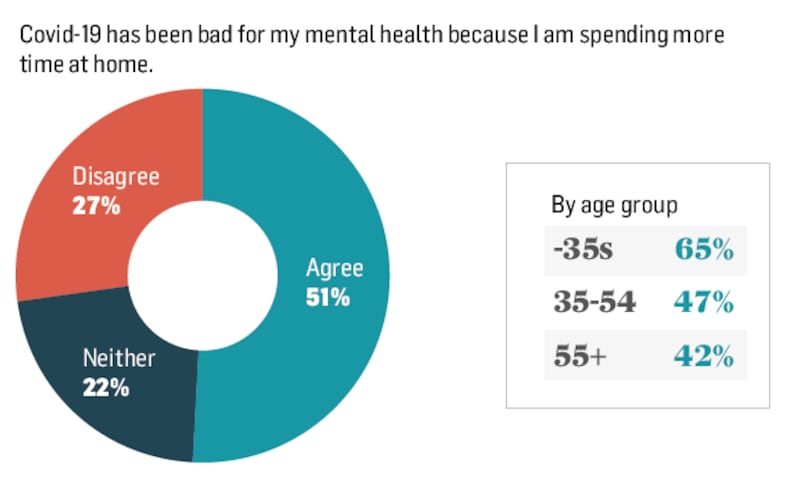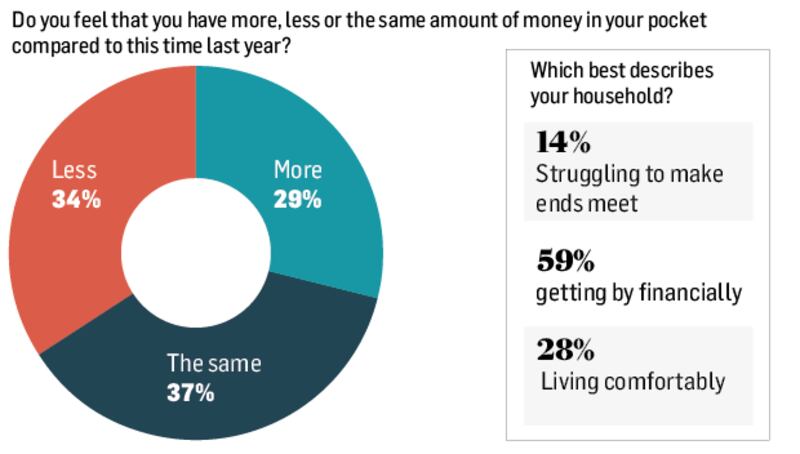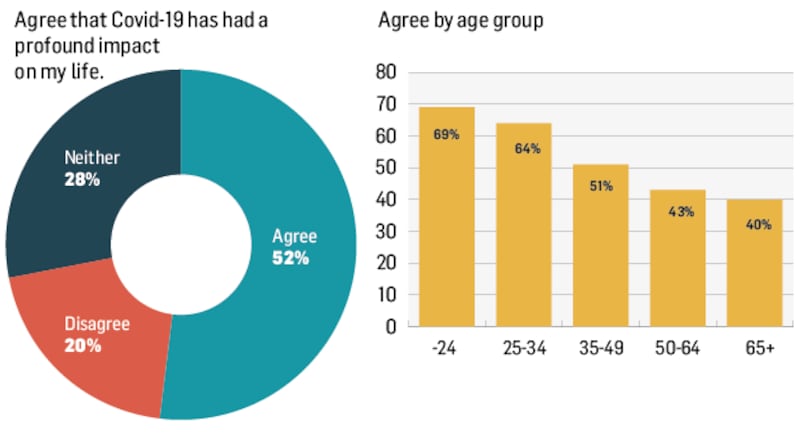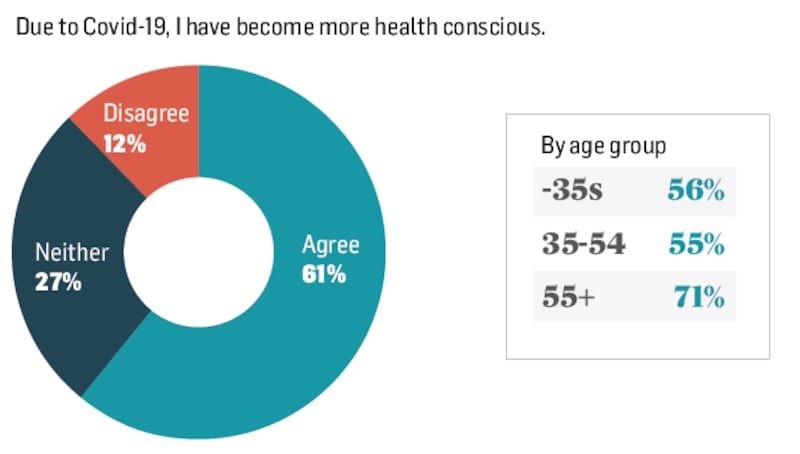The results of the 2021 Sign of the Times survey by Behaviour & Attitudes are published by The Irish Times today. The annual snapshot of Irish life combines quantitative and digital qualitative techniques with B&A published data on the economy, health, technology and shopping. The research was conducted in January and February 2021.
The 2020 Sign of the Times survey was full of omens and presentiments. Sign of the Times is an annual study of Irish life by market research company Behaviour & Attitudes, and last year’s instalment was published by The Irish Times just as the first lockdown was imposed.
The groundwork for the survey had been done before the pandemic really took hold in Europe. Yet, it was striking that there was already a palpable feeling of unease, a sense of the fragility of the way things were. What we now look back on as the old normal was already steeped in apprehension.
Some of the phrases that leapt out of the 2020 survey were: “an underlying sense of anxiety, with many feeling that we’re living on the edge”; it “feels like it wouldn’t take much for it to come crashing down”; there is “no evidence of a back-up plan”.
We have, after 12-months residency in Covidland, this contradictory set of impulses. We want to get the hell out of the place, but we want to take souvenirs with us
One respondent at the time pointed to the way early childcare facilities had almost closed at the end of 2019 because they couldn’t get insurance: “Crisis averted this time, but what will be next?”
One of the things Irish people were afraid of on the eve of the pandemic was a “major healthcare crisis”.
Well, we’ve had that in spades. A year on, we’ve had, in common with the rest of the world, a harsh lesson in the individual and collective frailty of the human condition – but also in its resilience. If, 12 months ago, we worried about being tipped over the edge, we now know what the other side of that edge looks like. It’s bad – but not all bad.
This has been the year of the Great Contraction. Our lives, and our mental horizons, have been narrowed and constrained. Our range of daily experiences has shrunk. Our social contacts have diminished.
But the contraction is also an intensification. We have been, collectively, domesticated. We have become explorers of the great indoors. Our home space has become our home place. And this is not an entirely unwelcome development. It has been enforced and far too protracted, but it has also created, for many of us, something we would like to hold on to.
We have, after 12-months residency in Covidland, this contradictory set of impulses. We want to get the hell out of the place. But we also want to take a lot of souvenirs with us.

Mental impact
Perhaps the most striking feature of the 2021 Sign of the Times study is the suggestion that the Great Contraction is mental as well as physical.
Why, for example, does the proportion of people who agree that “Covid-19 has had a profound impact on my life” decline step-by-step in accordance with age? The figures are stark: nearly 70 per cent of the under-25s identify a profound personal impact, compared to just 40 per cent of the over-65s.
On the face of it, this makes no sense. The one thing that everybody knows about Covid-19 is that it gets more dangerous with age. In general, the younger you are, the less you have to fear. This is why public health messaging has been particularly adamant that older people should be most cautious.
Maybe people who have grown up in the hyperconnected, globalised Ireland are more used to having a sense of being constantly plugged in to a wide network of friends
But the impact that people have in mind is not the direct one of being infected with the virus. It is the effect on the patterns of behaviour they take for granted. It is about what they’re used to.
Older people in general lead more confined lives, so the extra limitations of the pandemic have been, perhaps, just more of the same. Younger people, on the other hand, are intensely sociable. They feel the loss of novelty and connection much more sharply.
This difference is reflected in the way people feel about their own mental health. Among those under 35, a massive 65 per cent feel that the pandemic has been “bad for my mental health because I am spending more time at home”. Among those over the age of 55, just 42 per cent feel the same way.
It is a speculative thought, but perhaps there is a deeper cultural shift behind this disparity. Maybe people who have grown up in the hyperconnected, globalised Ireland are more used to having a sense of being constantly plugged in to a wide network of friends and colleagues than those whose mentalities were formed by a more intimate kind of society.
And maybe that’s why the young experience the Great Contraction as more of a deprivation and more of a challenge to their mental health.
What is obvious, in any case, is that the differences in our experiences of the pandemic are rooted both in objective reality and in the more nebulous (but no less meaningful) realm of expectations.

Money and space
The objective stuff comes down to money and space. The study shows that the economic effects of the pandemic have widened the existing gap in financial security.
There has been a broad shift downwards on this scale, and it is worth noting. One of the strangest aspects of Irish reality is the difference between the big figures of economic statistics and the lived experiences of Irish people.
Earlier this month, the official Central Statistics Office figures for the Irish economy in 2020 delivered the cheery news that, in spite of the plague, gross domestic product grew by 3.4 per cent over the year.
Having an extra room where remote working can be removed from family life can be more calming than Prozac
But such buoyant statistics do not tell the story of the domestic economy in which most of us work. The Sign of the Times surveys give a different, darker snapshot.
In the 2020 study, 40 per cent of people said they were “living comfortably” – now this is down to 28 per cent. At the other end of the scale, the proportion reporting themselves as struggling to make ends meet has risen from 12 to 14 per cent. More and more of us are bunched in the middle (“getting by”) – a category that has increased sharply from 48 to 59 per cent.
This may be another reason why younger people are finding the pandemic more stressful. Older people are more likely to have achieved some kind of equilibrium in their finances. Money matters to mental health – you don’t have to be rich but you do need not to be worrying all the time about how to pay the bills.
But money, in our dysfunctional housing system, also shapes another of the most basic experiences of lockdown: space. When we are thrown back into the domestic sphere, the size of that globe becomes crucial. Having a garden can be a lifesaver. Having an extra room where remote working can be removed from family life can be more calming than Prozac.
Here, again, age is surely a factor. The households with the most space are those made up of older people. Younger people are much more likely to be living in houses or apartments where there are more occupants than rooms.
If money and space are the hard currency of our different lives in Covidland, the less tangible coinage of our experience is custom. The pandemic changes things, but change itself is a relative concept. What is new to some people is familiar to others.

Radically domesticated
A large part of the population, especially that broad, youngish middle-class that has the privilege of being able to work from home, has been radically domesticated. Young families have been forced to spend a lot more time in close quarters with each other. And, for all its problems and hassles, much of this is both new and welcome.
It should be said, of course, that for many people this confinement is hellish. If you are in a relationship with a bully or a domestic tyrant, the inability to escape makes it all the more toxic.
But the Sign of the Times study suggests that, for a lot of us, domestication is, on the whole, a pleasant and maybe even a profound experience.
Relationships between parents and children have been getting steadily better
This is not in itself a great compliment to Irish society. It tells us that the work/life balance has been badly askew. The simple fact is that most of us want to spend time with our loved ones. We need a home life as a shelter, an anchor and a touchstone. The Sign of the Times study suggests that spending more time at home is something most people already wanted. The shame is that it takes a pandemic to make it happen.
It is interesting to consider these findings in relation to the big study of the health-related behaviour of young people in Ireland published earlier this month. One of the stories it told was a very positive one: we are getting better at communicating with our children – even with the supposedly stroppy adolescents.
In 1998, just 73 per cent of Irish children aged between 10 and 17 said they found it easy to talk to their mother about things that bothered them. Now, the figure is 84 per cent. In 1998, a mere 53 per cent said the same about their fathers. Now, it’s 72 per cent. Twice as many 15 to 17-year-old girls now say they can talk to their fathers than in 1998.
Maybe this is one of the big reasons why the experience of the pandemic has had its good side for family life. Relationships between parents and children have, on this evidence, been getting steadily better. The intensification of those relationships during the lockdowns is thus less of a burden and more of a pleasure.

The great anxiety
There is another side to the Great Contraction – what the authors of the Sign of the Times study call the “finite capacity of worry”. The pandemic became the sum of all fears, the great anxiety that has, to a large extent, crowded out the others.
It is particularly striking that there has been a sharp decrease across all regions and age groups of agreement with the proposition that “environmental issues have a profound effect on my life”. The planet, it seems, has shrunk to the size of our own rooms.
It may well be the case that this is true of a wider range of issues, that thinking about politics and society has been denied headspace by the big interloper that has taken up residence.
But there is also reason, in the study, to think that these concerns will return as the pandemic recedes. What we can see for sure is that we don’t want simply to go back to the way things were.
This has been a dark time, a time of grief and loss and impoverishment. But within it there have been discoveries of deeper bonds with our immediate families, of reconnection with nature, of the vitality of social capital and of life experiences that are marked by their quality, not just their quantity.
There is at least some sense in which less has been more, in which the reduction of our lives has also been a kind of distillation. If we want to hold on to those gains – won at such awful cost – we cannot simply swap the one big anxiety for the multiple insecurities that preceded it.












